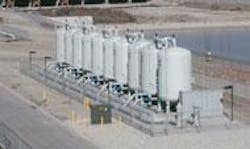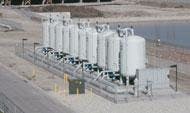Remediating Perchlorate-Contaminated Groundwater Using Ion Exchange
By Peter E. Ritchey
Perchlorate is a component of explosives, fireworks, matches, and solid rocket fuels. It is found in water supplies near former perchlorate manufacturing sites, and in locations where solid rockets have been used or serviced.
Medical studies have shown that when ingested, perchlorate (a stable anion of ammonium perchlorate) interferes with normal functioning of the thyroid gland and may, according to the EPA, "also result in thyroid gland tumors."
From more recent studies, perchlorate is believed to be an endocrine disrupter, adversely affecting the normal growth of fetuses and children. Perchlorate is stable in groundwater, and has been identified in 75 releases in 22 states by the EPA.
Perchlorate removal from groundwater via ion exchange has been commercially accepted by the water treatment industry and is being used in dozens of installations across the United States.
In February 2000, Calgon Carbon Corporation's ISEP® System received the approval of the California Department of Health Services for the treatment of perchlorate for drinking water distribution. ISEP technology is one of a small group of technologies to have received this endorsement. (ISEP continuous ion exchange system removes the perchlorate; the ISEP+™ catalytic destruction system destroys the compound.)
There are three primary types of perchlorate-removal treatment systems:
• non-regenerable fixed bed
• regenerable (ISEP) moving bed
• regenerable fixed bed (not yet in commercial use)
The choice between the first two is made on the basis of the chemistry of the water to be treated, the speed of system installation, operational ease, and cost.
One additional consideration is the water supplier's location relative to the contaminant plume, and whether other removal systems will be brought online. A water supplier on the edge of a contaminant plume might not have a problem in five or 10 years if larger systems that are brought online closer to the center of the plume cause the plume to retract. In this type of scenario, minimizing the cost of the system makes sense. Water suppliers have to make those decisions based on the opinions of their hydrogeologists.
Non-regenerable systems
Non-regenerable systems offer the advantages of simplicity. They can be installed quickly: modular systems enable complete package delivery of vessels, piping, instrumentation and resin with six weeks. Systems can be running within a week after delivery – they only need to be set on a level surface, such as a concrete pad or railroad ties.
They also have few moving parts, require less operator intervention and expertise, and provide the convenience of resin replacement (by the supplier), rather than regeneration.
The disposable anion exchange resins used in non-regenerable systems have a much higher selectivity for perchlorate than regenerable resins. Because these resins continue to remove perchlorate long after all other anionic species have reached breakthrough, they can be online for weeks or months before they are saturated. After complete breakthrough of perchlorate is established, the spent resin is removed from the system and incinerated; virgin resin replaces the spent. Resin incineration, with certificates of destruction, allow absolute mitigation.
Several types of anionic resin are commercially available for this system, from a simple SBA Type 1 resin to the highly selective bifunctional resins. Calgon Carbon has also modified commercially available resin in its CalMedia program to lower operating costs for perchlorate treatment.
However, net present value calculations usually show non-regenerable systems to be more expensive than regenerable systems, due to the ongoing costs of incinerating and replacing used resin. However, many users opt for the installation speed and operating convenience of non-regenerable systems in spite of the higher expense. Currently, more than 3.6 mgd of groundwater are being treated with this technology, with an additional 11.5 mgd expected before the end of the year.
Regenerable Moving Bed Systems
Regenerable moving bed systems are favored at higher flow rates (due to economics) and when the water has a high ionic load (due to other pollutants – nitrates, sulfates, and some biocarbonate – that need to be removed).
Calgon Carbon's ISEP regenerable moving bed system uses a more-easily regenerable acrylic resin with a brine regeneration (a standard sodium chloride solution similar to that used in a home water softener system). The technology has the advantage of maximizing the performance of the system though reduced regenerate usage, reduced resin requirement, and steady-state operation.
Currently, 3.6 mgd of groundwater are treated with ISEP technology, with more than 21.6 mgd of additional capacity expected to come online in 2003. The operating system at La Puente Valley County Water District in California has been operating at less than 4 ppb perchlorate; treated water samples at Calgon's analytical lab are registering less than 2.5 ppb.
Regenerable moving bed systems have more moving parts and the resins require regeneration after a matter of hours online. Nonetheless, by minimizing the volume of waste brine and the amount of regenerate needed, the ISEP technology delivers lower operating expenses than a non-regenerable system.
Regenerable Fixed-Bed Systems
Regenerable fixed-bed systems have been the subject of speculation for some time, but their promise hasn't been proven. They use the same ion exchange technology as regenerable ISEP systems, but current operating costs are higher due to lower brine regeneration efficiencies and higher waste volumes. A full-scale plant is probably three to five years away.
The lure of regenerable fixed-bed systems lies in their ability to use two types of resin. First, acrylic regenerable resin can be used for perchlorate removal and regenerated with a brine solution. Second, a highly perchlorate selective resin (such as Oak Ridge Bi-Quat) can be used. This resin offers substantially longer run times between regenerations.
The key to lower operating costs will be how many times the regenerate can be re-used and how difficult it will be to destroy the perchlorate. The regeneration solution, a FeCl3/HCl solution, is highly corrosive.
If these two questions can be favorably answered, a regenerable fixed-bed system could be almost as simple as a non-regenerable fixed bed system, with used resin being taken off-site for regeneration. However, with so much to be proven, development costs will undoubtedly have to be underwritten by a PRP with major liabilities.
About the Author:
Peter Ritchey is a Senior Process Engineer with Calgon Carbon Corp. in Pittsburgh, PA. He currently heads the perchlorate removal projects from the laboratory level through full-scale operation and has been the lead engineer on multiple perchlorate remediation groundwater projects using both the fixed-bed and continuous regenerate processes. He is currently involved in the technology evaluation of perchlorate-removal ion exchange technologies. Ritchey earned a B.S. in Chemical Engineering from Pennsylvania State University.

